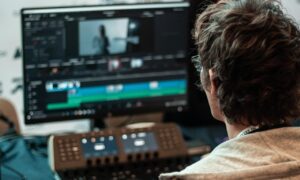The art of video editing has undergone a remarkable transformation over the years, evolving from cumbersome analog methods to sleek and sophisticated digital technologies. This journey from analog to digital editing has not only revolutionized the way we create and consume video content but has also opened up a world of possibilities for filmmakers, editors, and content creators. In this article, we’ll explore the fascinating evolution of video editing, from its humble beginnings in the analog era to the cutting-edge digital tools and techniques that define modern editing workflows.
The Analog Era: Splicing and Cutting Film by Hand:
In the early days of filmmaking, video editing was a laborious and time-consuming process that involved physically cutting and splicing celluloid film by hand. Editors would meticulously trim and rearrange individual frames of film to create seamless transitions between shots, a process that required precision, patience, and a steady hand. While this analog method of editing laid the foundation for modern editing techniques, it was inherently limited by the constraints of physical film and equipment.
The Advent of Linear Editing Systems:
The introduction of linear editing systems in the 1970s marked a significant milestone in the evolution of video editing. These early computer-based systems allowed editors to digitize video footage and manipulate it using specialized hardware and software. However, the editing process was still linear and sequential, requiring editors to assemble footage in a predetermined order from start to finish. While linear editing systems represented a leap forward in efficiency and flexibility compared to analog methods, they were ultimately limited by their rigid structure and lack of non-linear editing capabilities.
The Digital Revolution: Non-Linear Editing Comes of Age:
The digital revolution of the 1990s brought about a seismic shift in the world of video editing, with the widespread adoption of non-linear editing (NLE) systems. Unlike linear editing systems, which required editors to work in a sequential manner, NLE systems allowed for greater flexibility and creativity by enabling editors to manipulate video footage in a non-linear fashion. With the advent of desktop editing software such as Avid Media Composer, Adobe Premiere, and Final Cut Pro, editing became more accessible to a broader range of users, empowering filmmakers and content creators to realize their creative visions with greater ease and efficiency.
The Rise of Digital Effects and Compositing:
Alongside the development of non-linear editing systems, the digital revolution also ushered in a new era of digital effects and compositing. With the advent of powerful computer graphics software such as Adobe After Effects and Autodesk Flame, editors gained access to a wealth of tools and techniques for creating stunning visual effects, motion graphics, and composites. From simple color corrections and green screen keying to complex 3D animations and CGI, digital effects and compositing have become indispensable tools for enhancing the visual appeal and storytelling potential of video content.
The Emergence of Online Editing and Collaboration:
In recent years, advances in cloud computing and high-speed internet connectivity have revolutionized the way video editing is performed, with the emergence of online editing and collaboration platforms. These cloud-based editing solutions allow editors to access and edit their projects from anywhere in the world, enabling seamless collaboration between remote teams and streamlining the post-production workflow. With features such as real-time collaboration, version control, and cloud storage, online editing platforms have democratized the editing process, making it more accessible and efficient than ever before.
The Future of Video Editing: AI and Machine Learning:
Looking ahead, the future of video editing promises to be even more transformative, with advancements in artificial intelligence (AI) and machine learning poised to revolutionize the editing process. AI-powered editing tools can analyze footage, identify key moments, and automatically generate edits based on predefined criteria, saving editors time and effort. Machine learning algorithms can also assist with tasks such as color grading, audio mixing, and content optimization, allowing editors to focus on the creative aspects of their work while the technology handles the technical details.
Conclusion:
The evolution of video editing from analog to digital represents a journey of innovation, creativity, and technological advancement. From the painstaking process of splicing film by hand to the seamless flexibility of non-linear editing systems, each stage of this evolution has brought about new possibilities and opportunities for filmmakers, editors, and content creators. As we look to the future, the continued development of digital technologies such as cloud-based editing platforms, AI, and machine learning promises to further revolutionize the editing process, empowering creators to push the boundaries of storytelling and visual expression. So, whether you’re a seasoned editor or a budding filmmaker, the evolution of video editing opens up a world of possibilities for bringing your creative vision to life in ways never before imagined.



































